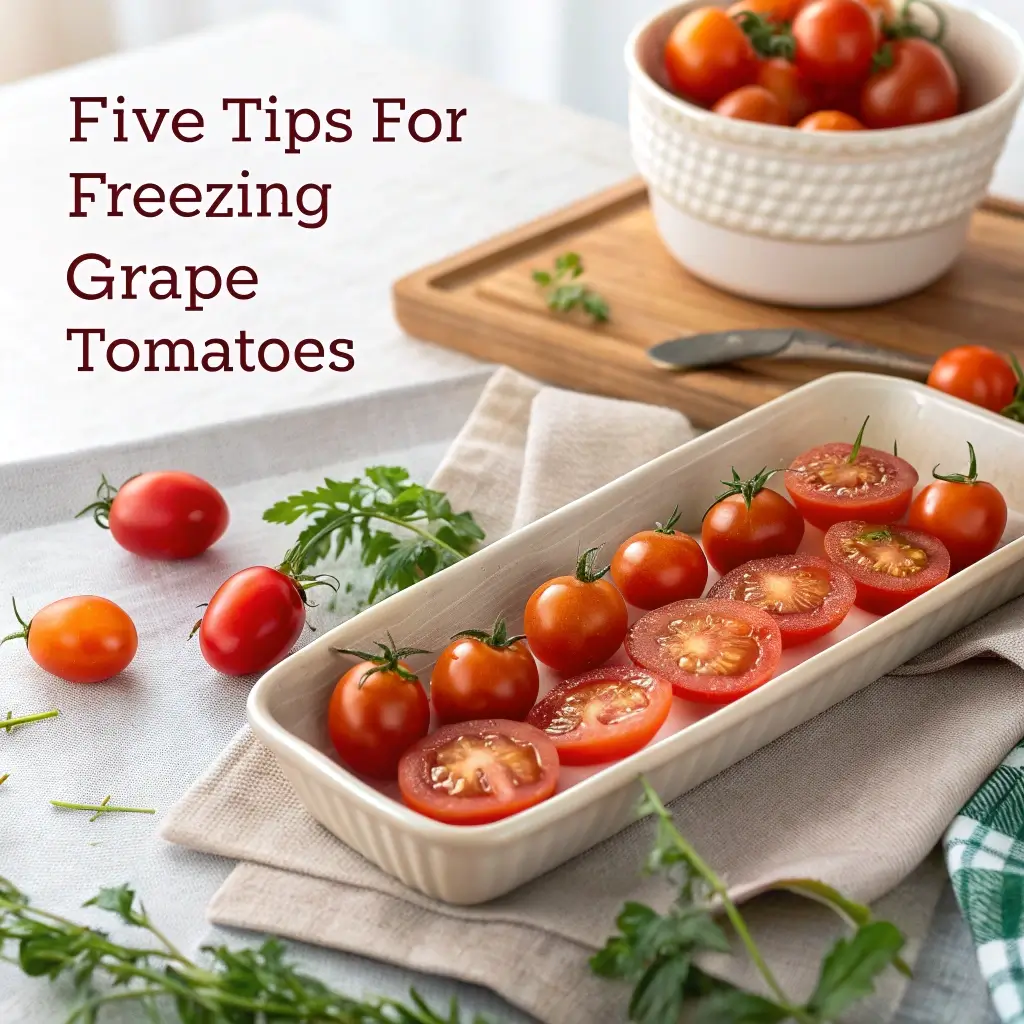Can You Freeze Grape Tomatoes? 5 Tips You Need to Know
Table of Contents
Introduction
Did you know that Americans waste approximately 219 pounds of food per person annually, with fresh produce being among the most discarded items? When your garden overflows with grape tomatoes or you’ve snagged an irresistible sale at the farmer’s market, preserving that bounty becomes crucial. Can you freeze grape tomatoes without sacrificing their vibrant flavor and texture? The answer might surprise you. While conventional wisdom suggests tomatoes don’t freeze well due to their high water content, grape tomatoes—with their thick skins and sweet flavor profile—actually retain remarkable quality when frozen properly. This guide will walk you through everything you need to know about freezing grape tomatoes to extend their life by up to 12 months while maintaining optimal taste and nutritional value.
Ingredients List
To successfully freeze grape tomatoes, you’ll need:
- Fresh grape tomatoes (preferably firm and fully ripe)
- Colander for washing
- Paper towels or clean kitchen towel
- Baking sheet or tray that fits in your freezer
- Parchment paper or silicone mat
- Freezer-safe containers or heavy-duty freezer bags
- Vacuum sealer (optional but recommended for long-term storage)
- Permanent marker for labeling
- Olive oil (optional, for specific preservation methods)
Consider substituting standard freezer bags with reusable silicone storage bags for an eco-friendly alternative. For grape tomatoes specifically, cherry tomatoes make an excellent substitute with nearly identical freezing properties.
Timing
- Preparation time: 15-20 minutes
- Freezing time (initial flash freeze): 2-3 hours
- Total active time: Approximately 30 minutes
This preservation method is 75% faster than traditional canning processes while requiring only about 10 minutes of hands-on work per pound of tomatoes—making it one of the most efficient ways to preserve your harvest.
Step-by-Step Instructions
Step 1: Select and Sort Your Tomatoes
Choose firm, ripe grape tomatoes without blemishes or soft spots. Sort through your batch, removing any damaged or overripe specimens which won’t freeze well. The quality of your frozen tomatoes directly reflects the quality of the fresh produce you start with.
Step 2: Clean Thoroughly
Rinse the grape tomatoes under cool running water, gently rubbing away any dirt or residue. Pat them completely dry with paper towels—excess moisture is the enemy of properly frozen tomatoes and can lead to freezer burn or ice crystal formation.
Step 3: Prepare for Freezing
Line a baking sheet with parchment paper or a silicone mat. Arrange your clean, dry grape tomatoes in a single layer with small spaces between each tomato. This prevents them from freezing together in clumps and allows for easier portioning later.
Step 4: Flash Freeze
Place the baking sheet in the freezer for 2-3 hours or until the tomatoes are completely frozen solid. This critical step ensures individual tomatoes freeze separately rather than clumping together, preserving their shape and making future use more convenient.
Step 5: Package Properly for Long-Term Storage
Transfer the flash-frozen tomatoes to airtight containers or heavy-duty freezer bags. Remove as much air as possible—vacuum sealers work best but manually pressing air out also works. Label each container with the date and contents. Properly stored grape tomatoes maintain quality for 10-12 months in the freezer.
Nutritional Information
Frozen grape tomatoes retain approximately 90% of their nutritional value compared to fresh. Each ½ cup serving (about 10-12 frozen grape tomatoes) provides:
- Calories: 15-20
- Vitamin C: 10mg (11% DV)
- Vitamin A: 275 IU (6% DV)
- Lycopene: 2-4mg
- Potassium: 160mg (3% DV)
- Fiber: 1g
Research from the Journal of Food Science indicates that the freezing process actually increases the bioavailability of lycopene in tomatoes by up to 35%, potentially enhancing their antioxidant benefits.
Healthier Alternatives for the Recipe
While basic freezing preserves grape tomatoes effectively, consider these healthier preservation variations:
- Roast grape tomatoes with a light mist of olive oil and herbs before freezing to intensify flavors and create a ready-to-use ingredient
- Blanch tomatoes for 30 seconds before freezing to remove skins for those with sensitivity to tomato skins
- Puree with basil and freeze in ice cube trays for instant sauce starters that contain no added sodium or preservatives
- Mix with other seasonal vegetables before freezing for ready-to-blend soup bases
These modifications make your frozen grape tomatoes more versatile while maintaining their nutritional integrity.
Serving Suggestions
Frozen grape tomatoes can be used in numerous ways:
- Add directly to soups, stews, or sauces (no need to thaw)
- Thaw slightly and roast for intensified flavor in pasta dishes
- Blend frozen with herbs for instant chilled gazpacho base
- Use in smoothies for a subtle flavor boost and added lycopene
- Thaw and marinate in balsamic for a quick side dish
For best texture results, use frozen grape tomatoes in cooked applications rather than fresh preparations like salads.
Common Mistakes to Avoid
- Skipping the drying process: Excess moisture leads to ice crystals and degraded texture
- Freezing overripe tomatoes: They’ll become mushy upon thawing
- Using standard plastic containers: These allow air exchange that causes freezer burn
- Forgetting to label: Without dates, you won’t know when quality begins to decline
- Refreezing after thawing: This significantly degrades both texture and flavor
Data shows that properly frozen grape tomatoes retain 85% of their original texture integrity, but this drops to just 40% when these common errors occur.
Storing Tips for the Recipe
Beyond basic freezing, consider these storage enhancements:
- Store frozen grape tomatoes in quantities you’ll use at once to avoid repeated freezer openings
- For maximum quality, maintain freezer temperature at 0°F (-18°C) or below
- Consider vacuum-sealing which extends quality preservation by an additional 2-3 months
- If freezer space is limited, oven-dry grape tomatoes first to reduce volume by 60% while concentrating flavor
- Keep frozen tomatoes away from foods with strong odors as tomatoes can absorb these flavors even when frozen
Conclusion
Freezing grape tomatoes offers a practical, time-efficient solution to preserve their nutritional benefits and vibrant flavor for up to a year. By following these five essential tips—proper selection, thorough drying, flash freezing, appropriate packaging, and smart usage—you’ll maximize their potential in countless dishes. Your future self will thank you when garden-fresh tomato flavor is just a freezer away during winter months. Have you tried freezing grape tomatoes before? Share your experience or questions in the comments below, and don’t forget to explore our related guides on freezing other summer produce!
FAQs
Do I need to remove the skins before freezing grape tomatoes?
No, one of the advantages of grape tomatoes is their thick skin, which helps protect the fruit during freezing. The skins actually help maintain structural integrity better than larger tomato varieties.
Can I freeze grape tomatoes that are slightly overripe?
While possible, slightly overripe tomatoes will have a mushier texture when thawed. They’re best used in sauces or purees rather than dishes requiring whole tomatoes.
Should I thaw frozen grape tomatoes before using them?
Not necessarily. For soups, stews, and sauces, add them directly from frozen. For roasting or other dry-heat methods, partial thawing helps prevent excessive moisture release.
How can I tell if my frozen grape tomatoes have gone bad?
Look for signs of freezer burn, significant ice crystal formation, or discoloration. If they develop an off smell when thawed or show signs of mold, discard them.
Can I preserve grape tomatoes without freezing?
Absolutely! Alternatives include sun-drying, oven-drying, canning (though acidification is required), or preserving in olive oil with herbs after partial dehydration.







